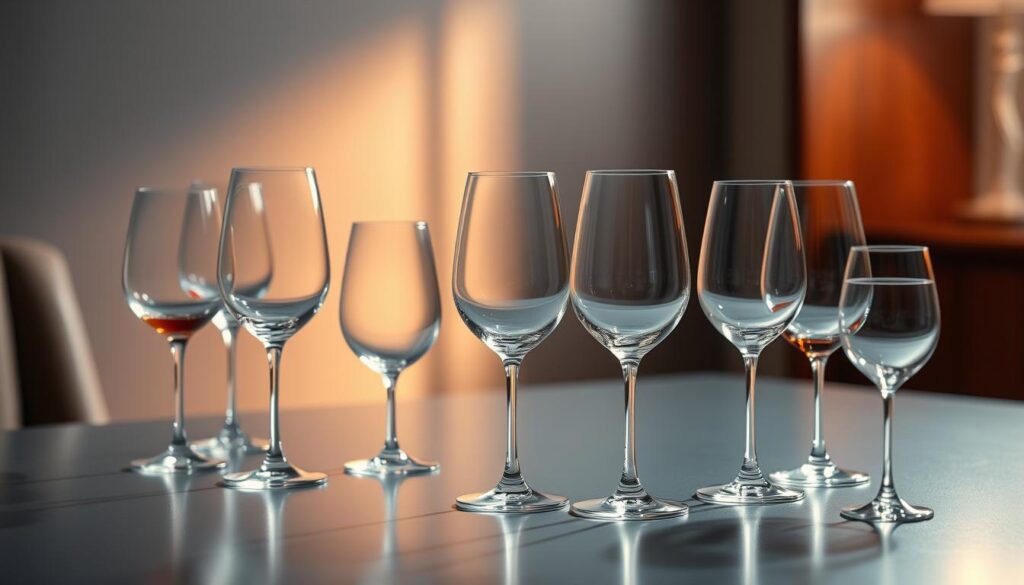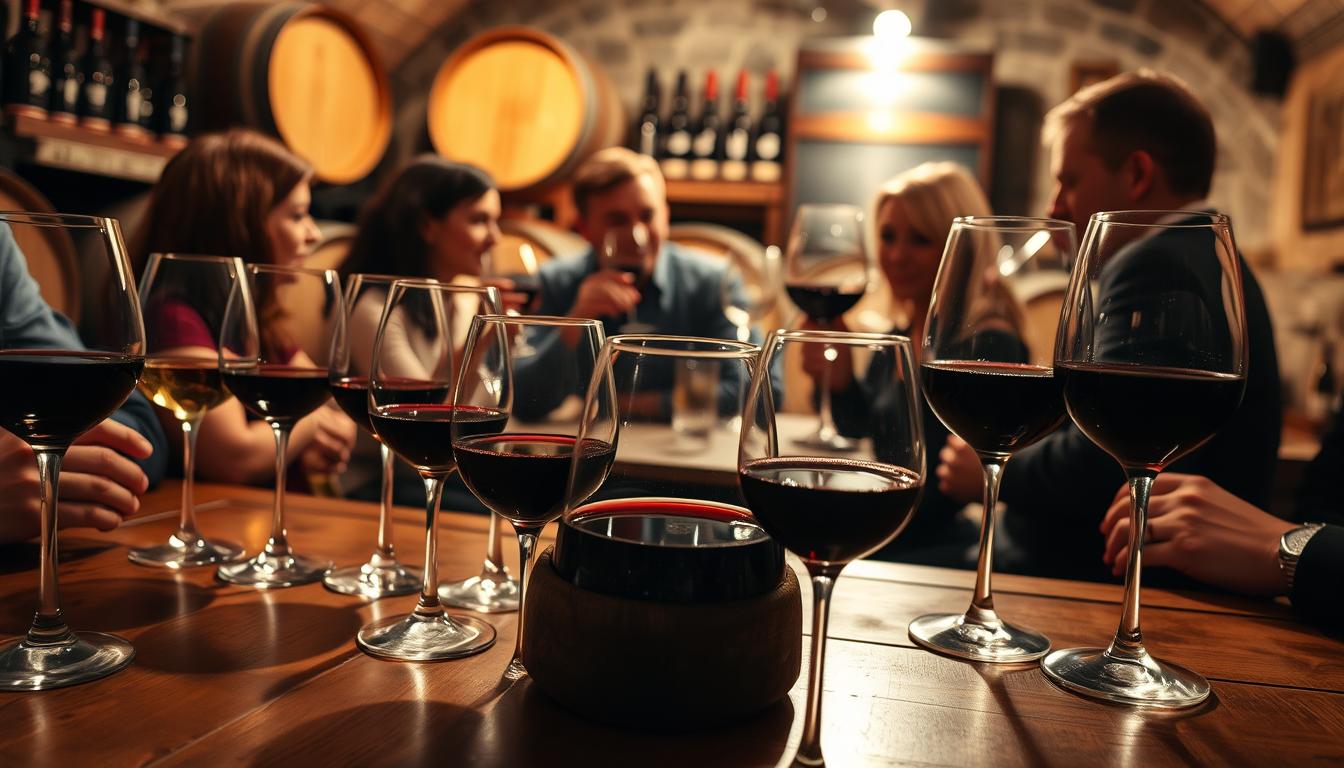Wine tasting is not just for the elite. It’s an art that uses all your senses. You look at the wine’s color and feel, smell its scents, and taste its flavors. This way, you get to understand how wine is made and its beauty. The sound of wine pouring adds to the experience too.
Key Takeaways
- Wine tasting engages all five senses to appreciate wine fully.
- Observing wine’s color and consistency can reveal much about its character.
- The aroma of wine holds key information about its flavor profile.
- Each sip reveals nuances in texture and taste, enhancing the wine tasting experience.
- Even sound can enrich your overall perception during a wine tasting.
Understanding the Five S’s of Wine Tasting
The Five S’s method makes wine tasting better. It helps people learn how to taste wines fully. This method is loved for its detailed look at wine’s qualities. Let’s explore each of the Five S’s for your next wine adventure.
See: Observing Color and Clarity
First, look at the wine’s color and clarity with the glass in the light. The color tells about the wine’s age and the type of grape. Bright colors often mean a younger wine. Older wines look more muted.
Also, check if the wine is clear or has bits in it. This tells about the wine’s quality and how it was made.
Swirl: Releasing Aromatic Compounds
Then, swirl the wine softly in your glass. This mixes it with air and brings out smells. Swirling helps the wine “breathe” and show more scents. On great wine tours, experts teach this step to smell all the wine’s aromas better.
Smell: Identifying Aromas
After swirling, sniff the wine. Try to pick out different smells like fruit or spice. Smelling is key to writing good wine notes. It finds details that change by how the wine is made and aged.
Sip: Analyzing Texture and Flavor
Sip a bit and think about how it feels, its tartness, dryness, and flavor balance. Move the wine around in your mouth. This helps find tastes you might miss at first. This part is vital for understanding a wine’s depth.
Savor: Reflecting on Overall Experience
Last, think about the whole tasting. Notice how the taste changes and how it finishes. Is it smooth or harsh? Does the taste stay or go away fast? This helps fully judge the wine’s quality and how it might age or pair with food.
Science Behind Wine Tasting
Wine tasting blends our senses, like taste, smell, and touch. We use our taste buds, nose, and how wine feels to enjoy it fully. This mix of science makes wine tasting more fun and insightful.
Role of Taste Buds and Olfactory Receptors
Your taste buds and nose are important for enjoying wine. Taste buds on your tongue spot five basic tastes. Your nose picks up scents that add to the taste. Knowing this makes following wine tasting tips easier and more fun.
The Importance of Somatosensory Cues
How wine feels in your mouth also matters in tasting. Some wines may feel prickly because of their acidity. Others might feel oily if they have more alcohol. Knowing these feelings helps you talk about wine better.
Combining Taste, Aroma, and Texture
In wine tasting, we aim to enjoy its taste, smell, and feel together. “Aroma” and “bouquet” might sound similar, but they’re different. Aroma is from the grape type. Bouquet comes from how the wine is made. Understanding these will make wine tasting more enjoyable.
Essential Wine Tasting Techniques
Learning how to taste wine can improve your experience. This is true whether you are new or have loved wine for years. Key steps include checking the wine’s look, sniffing its smells, and tasting it well. Everyone who enjoys wine should know these steps.
Visual Inspection: What to Look For
Looking at the wine is the first step. You should notice the wine’s color, clarity, and how clear it is. White wines can look pale yellow. Red wines may be deep purple. The color tells you about the wine’s age and the grape type. When you swirl the wine, you see its viscosity. This can tell you how much alcohol it has and its body.
Sniffing and Identifying Aromas
Smelling the wine opens up a world of scents. This greatly adds to your tasting. The smells come from the grapes and can be fruity, floral, or like herbs. Smells from making the wine include yeast or creamy scents. Aging the wine brings out earthy, spicy, or nutty smells.
Palate Assessment: Balancing Acidity, Tannins, and Alcohol
When you taste wine, think about how the acidity, tannins, and alcohol mix. Acidity makes the wine taste fresh and zesty. Tannins add structure and depth. A good wine balances these so that no single part overpowers the others. Also, think about the wine’s body and finish. This makes the tasting better.
Developing Your Palate: Tips for Training
For those who love wine, learning tasting skills matters. Training your palate lets you enjoy wine more. You’ll notice what makes each wine special.
Side-by-Side Wine Comparisons
Comparing wines side by side is a top wine tasting tip. It helps you spot the little differences in wines. You get better at telling wines apart this way.
Using the Wine Aroma Wheel
The Wine Aroma Wheel is a great tool. It helps with your wine tasting notes. This wheel makes it easy to name different smells in wine.
Keeping a Tasting Journal
Writing in a tasting journal is a smart wine tasting tip. It lets you keep track of the tastes and smells you find. This way, you remember what you like and why.
Practicing Blind Tastings
Blind tastings make you focus on what you’re tasting. You can’t see the bottle, so you guess based on taste. It’s a good way to learn more about wine.
Wine Tasting for Beginners
Starting with wine tasting is thrilling but can also feel a bit scary. Begin with the Five S’s: see, swirl, smell, sip, and savor. This helps you enjoy the wine’s looks, smells, and tastes.
It’s key to know about different wines and how to read a wine label. Labels show where the wine is from, what grapes are used, and when it was made. This info helps you choose wisely.
Try attending a wine tasting or a virtual one to learn more. These events let you try various wines and learn from experts. You can enjoy virtual tastings from home.
Tasting different wines is important. It helps you find out what you like. Keeping a tasting journal is a good idea too. You can write down what you think of each wine.
Local wineries and shops often have classes for beginners. These include hands-on tasting practices. They teach you the basics.
Discovering wines is a personal journey. Whether it’s a local event or online, the goal is to explore and enjoy. Wine tasting is about discovering and savoring the wide world of wine.
Wine Glassware and Temperature
Choosing the right glasses and serving wine at the perfect temperature is key for a fun wine tasting. The type of glass you use can really affect how the wine smells and tastes. Meanwhile, keeping wine at the right temperature can make your tasting even better during exciting wine tours.
The Right Glassware for Different Wines
Glassware is super important for tasting wine. Picking the perfect glass for each wine makes the smells and tastes even better. For example, red wines do great in big, round glasses because they need air to show off their smells. White wines, though, are better in smaller glasses that make their gentle smells stronger.

Sparkling wines shine in flutes or tulip glasses because they keep the fizz and make the smells stronger. Choosing the right glasses and knowing how to use them can make your tasting party amazing.
Optimal Serving Temperatures
Serving wine at the ideal temperature brings out its best smells and tastes. Reds are best a bit cool, around 60-65°F, to show off their flavors. Whites taste great chilled but not too cold, about 45-50°F, to keep them fresh and fruity. Each wine has a perfect temperature that makes it taste amazing, and this can make wine tours unforgettable.
Paying attention to these details can make your wine party or tour incredible.
Wine Tasting Events and Experiences
Joining a wine tasting event is a fun way to learn more about wine. You can go on special tours or have fun at home. Every event is a new way to enjoy the world of wine.
Finding the Best Wine Tasting Tours
For top wine tours, think about places famous for their vineyards. Napa Valley and Sonoma County in California are perfect. These tours have guided sessions and vineyard visits. They also have tastings to teach both new and expert wine lovers. Here’s a look at some well-known spots:
| Region | Highlights | Popular Tours |
|---|---|---|
| Napa Valley | Luxury Wine Tastings | Castello di Amorosa Tour |
| Sonoma County | Organic Vineyards | Kendall-Jackson Wine Estate |
| Willamette Valley | Pinot Noir Specialties | Oregon Wine Tours |
Hosting a Wine Tasting Party
Throwing a wine tasting at home is both fun and educational. Pick a theme, like different regions or grape types, and write down tasting notes. Match wines with foods to make the flavors pop and get everyone talking.
Virtual Wine Tasting Options
Virtual wine tastings are now a big thing. They let you enjoy the best tours without leaving your house. Wineries and experts send tasting kits by mail. This way, you can try wines from all over the world and rare ones too.
Wine and Food Pairing Essentials
Pairing wine and food right makes dinner special. It’s all about matching tastes like acidity, fat, and flavors. Let’s explore how to pair wine and food well.
Acidity and Fat Balance
Acidic wine cuts through fatty food’s richness. Look for “crisp” or “zesty” in wine notes. They match well with creamy pasta or cheesy dishes.
Matching Intensity and Flavor Profiles
It’s important to match wine and food intensity. A powerful red wine goes well with grilled steak. Wine notes help find a wine’s body and flavor, making it easier to choose.
Special Pairings for Spicy and Umami-Rich Foods
Spicy and umami foods need special wines. Try off-dry wines like Riesling for spicy food. It lessens the heat. For umami foods like soy sauce or mushrooms, earthy wines like Pinot Noir are great. These tips can make your meal even better.
Conclusion
Wine tasting is like going on a sensory adventure. It lets you explore and enjoy different wines. You can learn the five S’s—See, Swirl, Smell, Sip, Savor. This will make your wine experience better. Plus, knowing how taste and smell work adds to the fun.
Learning how to taste wine is key. Looking at the wine and tasting it helps improve your skills. Trying different wines, using a wine aroma wheel, and writing in a journal helps too. Blind tastings are also good practice. Using the right glass and temperature makes wine taste better.
There are many ways to enjoy wine tasting. You can go on tours, have a tasting party, or try it online. Learning what food goes well with wine makes it even better. At the end, wine tasting is fun and full of new things to discover. It’s a mix of science and using your senses.
